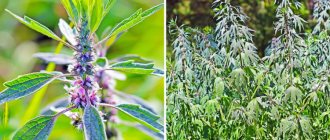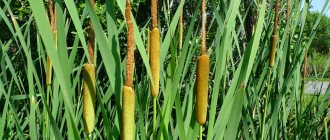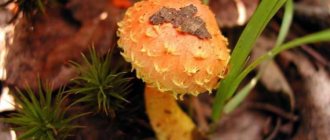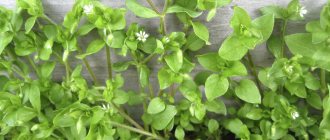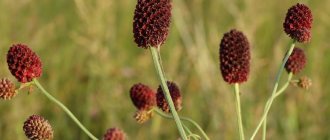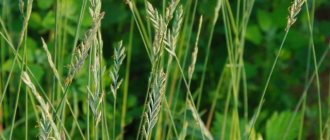Photo
Below you can see a photo of what parsley looks like:
How is it different from celery and cilantro?
Parsley, celery and cilantro are plants that belong to DIFFERENT biological species of the same family. They do not interbreed and do not form hybrids. From a culinary point of view, they differ in aromas and degree of compatibility with a given dish.
To never confuse these plants again, we suggest reading detailed articles about the differences. Read here how parsley differs from celery, and in this material you can learn about the differences from cilantro.
Petrushka: peasant young lady
In the first year of sowing, a root crop (root) with a leaf rosette develops, and the next year a peduncle grows, and by autumn, under favorable conditions, the seeds ripen.
On the shores of the Mediterranean Sea, since time immemorial, wild parsley has been growing in rocky areas, but if you want this southern beauty to grow bushy and curly in your garden, you should not only choose a sunny place for it, in Italian style, but also lay a lush garden bed a featherbed of fertile humus and plenty of water to drink all summer.
As for the temperature, in this sense she is not a capricious young lady, she can even spend the winter under the snow.
Parsley is grown from seedlings (the first sowing is in March), and the seeds are sown in the spring soil as soon as the snow melts. Seeds germinate at temperatures from +2° and above. It is sown in May, June, July, and August.
Moreover, the August crops will have time to take root and form a rosette of leaves. This parsley will safely overwinter under the snow, and in the spring it will give you the happiest, earliest delicious spring greens.
Plant ban in Russia
In the 21st century, parsley almost fell victim to an epidemic of prohibition.
In 2011, Roskomnadzor added parsley to the list of narcotic and toxic substances. Quite soon, however, it became clear that only parsley seeds could be potentially dangerous, and in quantities that obviously exceeded the usual use as seed material.
The chief narcologist of the Ministry of Health and Social Development, E. Brun, officially stated on 06/03/2011 that neither the sale of parsley nor its cultivation is either a criminal offense or a prohibited activity.
The ban on parsley in Russia is discussed in more detail in our article.
Curly leaf parsley: description
Curly parsley – Petroselinum crispum
A spicy biennial plant from the Apiaceae family. The second name is curly parsley.
The stem of the plant is branched and straight, the root is thickened, in the form of a spindle. Its height varies from 30 cm to 1 meter.
Parsley leaves are dark green, with a shiny top, triangular in shape, twice pinnately dissected.
It blooms with greenish-yellow flowers in June – July and produces ovoid achenes.
Curly parsley in fresh and dried form is widely used as a seasoning for salads, vegetable, fish and meat dishes.
In the wild, leaf parsley is common on the Mediterranean coast, and in cultivated form - in most countries of the world.
Chemical composition
Parsley is very rich in vitamins:
- IN 1;
- AT 2;
- AT 4;
- AT 5;
- AT 6;
- AT 9;
- ZZ;
- RR;
- E;
- N.
It is especially rich in vitamin A (9.5 mg per 100 g of weight), C (150 mg), K (160 mg). It contains:
- iron;
- copper;
- manganese;
- selenium;
- zinc.
BZHU content (per 100 g):
- protein – 3.7 g;
- fats – 0.4 g;
- carbohydrates – 7.6 g;
- calories – 49 kcal.
Benefits and harms
Parsley has never been considered as a primary food plant. Its main value is in essential oils, which give it aroma and healing properties.
- Parsley is widely used in folk medicine.
- Parsley gets rid of the odors of garlic and tobacco.
- The decoction helps with insect bites.
- Rubbing crushed seeds is recommended as a remedy against baldness.
Parsley even has a rejuvenating effect ! However, sometimes parsley can cause harm.
- It is contraindicated for pregnant women, since its stimulating effect on the muscles of the uterus can provoke a miscarriage.
- It should not be used by nursing mothers.
- Due to the general stimulant effect of parsley, it can cause headaches, insomnia and even hallucinations in particularly sensitive people.
FAQ
Although it is difficult to find a person who has not tried parsley, this plant still raises questions among many.
Is it a vegetable or a herb?
Parsley belongs to the herbaceous plants of the Celery family. Therefore, the answer to the question: is parsley a vegetable or a herb is a herb. The confusion arises because the roots of parsley are also used for food, just like greens.
Is the crop a root crop?
Parsley is a root vegetable due to its well-developed root, which is eaten. There are even separate varieties that are classified as root varieties. The root can reach up to 40 cm.
Current GOST and TU for these greens
Until recently, GOST R 55904-2013 (Fresh parsley. Technical conditions) was in force for commercial parsley.
This GOST determines the appearance, smell and taste, size of root crops, length of leaves, % non-compliance, content of chemicals and pathogenic factors. GOST establishes the following methods:
- packaging;
- sorting;
- acceptance;
- markings;
- control;
- transportation;
- storage of goods.
From 01/07/2018, a new GOST 34212-2017 was introduced.
Healing powers
Parsley is used as a seasoning in salads and in the preparation of first and second courses.
If you are stung by a bee or bitten by mosquitoes at your dacha in the summer, mash a parsley leaf and apply the juice to the sore spot.
If you like to chew fresh garlic or snack on sausage, don’t forget to eat your gluttony with a bouquet of parsley to get rid of the smell.
Doctors recommend parsley salads, decoctions and infusions to strengthen the heart, improve the functioning of the kidneys, liver and excretory system.
For older people, it is useful to apply a compress of crushed parsley leaves to age spots. And women in their prime use parsley to prepare cosmetic masks - the skin becomes light, fresh, silky, and the eyes shine!
Treatment and healing properties
Indications for the use of parsley in folk medicine:
- renal edema;
- cardiovascular diseases;
- chronic gastritis with reduced gastric secretion;
- stimulation of appetite, indigestion;
- urolithiasis, cystitis, urethritis;
- uterine bleeding, menstrual irregularities;
- inflammation of the prostate gland;
- indigestion, urination, bloating in children;
- carminative;
- restorative, etc.
For medicinal purposes, fresh parsley juice (including in mixtures), decoctions, infusions from seeds, roots, etc. are used. In cosmetology, a decoction of parsley root mixed with lemon juice removes freckles and whitens facial skin .
A decoction of parsley (2 teaspoons per glass of water) is used for weight loss. Drink half a glass of it when you feel hungry.
Parsley activates the body's fat metabolism and thereby suppresses the need for food.
Description and characteristics of the plant
Parsley is a biennial herbaceous plant with aromatic greens. There are three types of culture:
- leafy;
- root;
- decorative
The first two are used as food, the latter is grown as an ornamental plant. The plant looks like a medium-sized grass with carved, curly leaves. Stems are erect. The flowers of the plant are small and green in color. After planting the seeds, the plant develops a powerful stem and a rosette of leaves; in the second year, the plant throws out an inflorescence.
Varieties and types
Parsley is divided into leaf and root. Leafy varieties use fresh or dried herbs. The root is used for preparing soups and main courses. When choosing seeds for sowing, pay attention not only to the variety, but also to the growing season of the variety.
Leafy
Ordinary
The variety is mid-season (60-70 days), productive, with a strong aroma. Ordinary parsley is suitable for repeated cutting .
Gloria
Early productive variety. The leaves are large, well stored, suitable for transportation.
Aster
The variety is early, the first greens are ready for cutting at 55-60 days. The rosette of leaves is dense and curly. It is grown both in greenhouses and in open ground.
Breeze
Breeze is a productive mid-season variety . After cutting it does not turn yellow for a long time (good for sale). The leaves are wavy (not curly).
Root
Sugar
A popular high-yielding variety, ripening in about 95 days. The root vegetables are conical, 22-29 cm, weighing about 75 g. Greens are also used.
Alba
The variety is late-ripening (about 170 days). The root crops are powerful, weighing up to 200 grams or more. Root length – up to 30 cm.
The final
Mid-season (115-120 days), productive. Weight of the root of the Final variety is approx. 190 g .
Eagle
Mid-season (120-125 days), Unpretentious variety. The bushes are spreading, with lush greenery. The roots are conical, weighing about 150 g.
When and how to plant parsley.
Parsley is the herb that we always grow in our gardens and vegetable gardens.
There are no special secrets on how to plant parsley; planting parsley and dill is simple. It grows in almost any soil; parsley can grow in both sun and partial shade. Parsley grows best in light, fertile soil in a sunny location. Parsley is a biennial herb, so in May you can eat last year's parsley shoots, and by June wait for new shoots. The advantage of parsley is that it has a long period when planting parsley - it can be planted throughout the summer and even before winter, but don’t get too carried away, it may not overwinter well. Leaf parsley can be sown throughout the summer.
Where to sow parsley in spring
Parsley grows well in fertilized and loose soils; if you are growing root parsley, then loamy or sandy loam soil is suitable for it. This plant is light-loving and loves long daylight hours, so choose a sunny planting site. Suitable for growing parsley in the garden:
- direct sunlight,
- penumbra,
- scattered sun rays
The plant is moisture-loving, but you should not over-water the plantings, it does not tolerate it. Can be damaged by powdery mildew, rust, black dry rot. It must be protected from slugs and aphids.
When to plant parsley.
- Parsley for seedlings and for growing at home on windowsills can be planted from January during the days of the waxing moon to December.
- When can you plant dill and parsley in open ground? In open ground, in a garden bed, the time to plant parsley comes in the second half of April. But, if it doesn’t sprout (sometimes you sow and sow, but it doesn’t sprout), then you can sow several times a season. Parsley is a cold-resistant plant and the planting temperature for parsley is +1 ... +5 degrees. It can easily withstand frost.
Days of the waxing moon for planting parsley in 2016:
- when can you plant parsley in March - from 1 to 8 and from 24 to 31 March,
- in April they plant parsley - April 1 - 6 and 23 - 30,
- planting days for parsley in May are May 1 - 5 and May 23 - 31.
A significant disadvantage of parsley is that it takes a long time to sprout, so if you plant parsley on greens in April, it will be edible in June. Parsley seeds germinate more slowly, so you can soak the seeds before planting.
To speed up the cultivation of parsley in open ground, cover the crops with covering material. You can even do this. I decided to cover it with polyethylene, and then, after the first green shoots appeared, with lutrasil or other woven material. Under polyethylene, parsley will sprout quickly, and then by replacing polyethylene with woven material, you will not need to worry about the seedlings burning.
How to plant parsley seedlings.
Mini-greenhouses in the form of a container with drawers and a lid are well suited for growing parsley from seedlings.
- fill each cup with soil mixture,
- pour warm water,
- place 5 - 6 parsley seeds,
- sprinkle with soil for seedlings, 0.5 cm thick,
- cover the greenhouse with a plastic lid or plastic film,
- Place it in a bright place with a constant temperature, maybe even on a glassed-in balcony.
Parsley seedlings take a long time to emerge, about two weeks.
How to speed up the germination of parsley seeds (how to soak parsley seeds if they do not germinate):
- pour dry seeds with a glass of hot tap water,
- cool down
- when the water has cooled down, drain it,
- do this procedure several times during the day,
- wrap in a damp cloth,
- When the seeds hatch, plant them in the ground.
How to plant parsley with seeds in a garden bed in open ground.
It is best and most common to plant parsley in rows. You don’t even have to make a separate bed, but plant it between other vegetables that ripen slowly. It is preferable to grow parsley in beds with row spacing of 20–25 cm.
There is parsley: root and leaf.
How to plant root parsley.
Growing root parsley has its own subtleties, since the root system forms the root crop in the form of a cone, it must be sown immediately in a permanent place, in early spring (mid-April). Shoots take a long time to appear, so be sure to soak the seeds. It needs potassium for good growth, so before planting, add ash to the soil at the rate of 1 cup of ash per 1 meter of planting. In dry weather, water the prepared breast generously before adding the ash. In wet weather, ash can simply be scattered between rows on moist soil.
Tips on how to grow root parsley and celery.
Leaf parsley has beautiful leaves that can be used to decorate flower beds and garden design. The leaves are smooth, curly, and corrugated. The root of leaf parsley is thin and highly branched.
Parsley is an unpretentious herb, but it still grows better:
- in a well-lit garden bed,
- with fertilized, loose soil,
- for root - with a deep topsoil layer,
- Do not plant this plant in places where other umbrella crops such as celery, carrots, dill, cilantro, and caraway previously grew. Only after 4 years will it be possible to plant parsley, after these predecessors, so we are making a bed for parsley taking into account these recommendations.
How to plant parsley beautifully.
Thanks to its beautiful curly leaves and long-term preservation of its bright green color, until frost, parsley can be used as an ornamental plant. It can be used to decorate flower beds or plant at the edges in raised beds. Green parsley leaves also look beautiful in garden flowerpots. In addition, parsley can be trimmed, and then it grows back and you can reap several harvests of herbs.
superda4nik.ru
Where can I get seed and how much do seeds cost?
Varietal parsley seeds can be purchased retail at any specialized department, or ordered wholesale, including on the Internet (“Seeds by Mail”).
When ordering seeds by mail, pay attention to the minimum purchase amount restrictions!
Comparative prices for parsley seeds.
In Moscow
- Retail price : 2 g – 10-14 rubles.
- Wholesale : Italian Giant (1 kg) -1040 rubles, Spicy - 1200 rubles.
In Petersburg
- Retail price : 2 g – 9-14 rubles.
- Wholesale : Italian giant (50 g) – 650 rubles, Vega (100 g) – 600 rubles.
Beneficial properties of parsley
Many cooks, due to the fact that parsley has long become a favorite seasoning, do not even suspect that it has certain beneficial properties. Since ancient times, biennials have been cultivated not only as food, but also as a medicine. To this day, you can find numerous grandmother’s recipes using tops on the Internet. The beneficial properties of parsley are due to its chemical composition.
For medicinal purposes, only the seeds and roots of the plant are used. The parsley plant has a rich chemical composition. Its seeds contain a large amount of essential oils, and the root vegetable is rich in potassium, phosphorus, magnesium and healthy vitamins. The benefits of greens, other than the high mood from enjoying the aroma, have not yet been clarified. But it is known that seeds and root vegetables help with:
- heart and kidney diseases of various etiologies;
- spasms of transverse and smooth muscles;
- female and male ailments of a dysfunctional nature;
- iron deficiency anemia;
- gastritis and liver restoration;
- diabetes mellitus of the first and second types;
- in preventing the development of cancer.
Since ancient times, parsley seeds have been used to treat the kidneys, gastrointestinal tract and as a diuretic. Essential oils have a beneficial effect on smooth muscle tissue, relieving spasms.
But it should not be abused, especially for pregnant girls. The roots contain some substances that, if highly concentrated in the human body, can cause fetal loss.
Planting, care, harvesting and storage of crops
- Landing . The site for parsley is sunny or slightly shaded. The soil is loose, normal, but suitable and slightly acidic. Best predecessors:
- onion;
- cucumbers;
- potato;
- not umbrella ones.
tomatoes;
Fertilizers are organic in the fall, and phosphorus-potassium in the spring.
The seeds are pre-soaked or sown dry (they will sprout a week later). The sowing date depends on the growing season. Leafy varieties can be sown a second time in July, in which case they will produce a harvest until autumn and go away before winter. Sow in grooves 1-2 cm deep, the distance between grooves is about 15 cm.
To dry the parsley, sort through the greens and discard the withered and yellow leaves. The leaves are laid out in a layer of about 1 cm and exposed to the breeze. Stir occasionally. You can dry hanging parsley, tied in small bunches.
Under no circumstances should you dry greens in direct sunlight!
Parsley roots are dried in a similar way. They are first cut into thin slices. You can also dry the roots in a cool (50-60 degrees) oven , stirring occasionally. In this case, the roots can be crushed into crumbs.
Another way to preserve parsley is to freeze it. We talked about how to do this correctly in this article.
Growing parsley on a windowsill
Caring for parsley at home
If you decide to grow parsley at home, then sow it, as we just described, in seedling boxes with a substrate of vermicompost and coconut fiber laid on top of the drainage layer. The seeds are pre-treated in this way: they are filled with water for 2-3 days and changed twice a day, and a couple of hours before sowing, the seeds are dipped in a weak solution of potassium permanganate for half an hour. The depth of planting seeds into the substrate is no more than half a centimeter, but on top it is necessary to sprinkle the crops with a layer of loose soil 1 cm thick, and then place the container with the crops in a dark place.
If you want to speed up seed germination, cover the box with glass or film, but do not forget to ventilate the crops and remove condensation from the film.
As soon as shoots appear after two to three weeks, the seedling box is moved to the windowsill. Grown seedlings are thinned out so that the distance between them is at least four centimeters. The ideal thermal regime for parsley seedlings is 15-20 ºC. At lower temperatures, parsley seedlings slow down, and if the thermometer is too high, the seedlings dry out. The most important condition for normal seedling growth is long daylight hours.
If the days are too short, provide the seedlings with additional artificial lighting by placing a fluorescent lamp at a distance of 60 cm from the box.
- Pachypodium at home: care, types and varieties
Parsley will produce its first harvest at home in about a month and a half. A branch 10-12 cm high reaches optimal maturity - it can be cut and eaten, leaving part of the shoot with a third of the leaves in the box. Parsley on the windowsill is most often grown early ripening - it can be cut two weeks earlier than mid-ripening or late varieties. Parsley produces good yields at home in the following leaf varieties: Astra, Russian Feast, Fitness, Beads, Green Pearl, Morning Freshness, Gloria and others.
Growing parsley from root vegetables
This method is convenient because you don’t have to wait for the seeds to germinate. At the end of October, before frost, dig up parsley with roots up to 5 cm long and up to 4 cm wide. Place a layer of drainage into a seedling box disinfected with a strong solution of potassium permanganate, then a substrate for violets, into which transplant the parsley dug up in the garden almost right next to each other, leaving only the apical buds above the soil surface. Lightly compact the soil and water it, then take the box out onto an insulated balcony or onto an unheated veranda.
Water the parsley sparingly, and as soon as green sprouts appear, move the box to a bright room with a temperature of about 20 ºC. On cloudy days, young greenery may need additional lighting. When intensive growth begins, you need to water the parsley more often and more abundantly. If you do not make serious mistakes in care, by the New Year a green bed will grow on your windowsill.
Watering parsley
Caring for parsley involves regular and sufficient watering of the seedlings. Do not allow the soil in the boxes to dry out or become waterlogged: water at room temperature daily, but the amount of water should be moderate. Do not allow a crust to form on the surface of the substrate; destroy it by loosening.
Feeding parsley
Growing parsley from seeds involves liquid feeding of seedlings with environmentally friendly fertilizers, which are applied no more than twice a month. These can be organic fertilizers or mineral complexes from well-established manufacturers on the market.
Diseases and pests
Fungal diseases can cause great harm to parsley, such as:
- rust;
- powdery mildew;
- septoria;
- black and white rot, etc.
Various fungicides are used to combat them. Pre-sowing calibration of seeds and introduction of disease-resistant varieties into the crop are effective.
Insect pests:
- melon aphid;
- psyllid;
- carrot fly.
Control measures include the use of insecticides or folk remedies (spraying with herbal decoctions). A preventive measure is proper crop rotation.
Caring for parsley in open ground
Agrotechnical measures for caring for parsley in open ground and their frequency depend largely on weather conditions.
Watering and loosening
When watering, consider the following features:
- The plant bushes well and grows with good soil moisture, but does not tolerate waterlogging. Water according to weather conditions and soil type. So, on sandy soils in hot weather, daily soil moisture is allowed. On chernozem, parsley requires watering every other day.
- Water for humidification should not be cold.
- Water at the roots of the plant, without pouring on the leaves. Collected rainwater stored in containers is ideal.
- The optimal watering time is early morning or late evening. This is explained by the fact that drops falling on parsley leaves allow sunlight to pass through, and the green part of the plant can get burned from the prism effect.
- After moistening the soil, it is good to make mulch from a thin layer of humus. This is additional nutrition for parsley and protection against moisture evaporation.
Loosening the soil in beds with parsley is a mandatory measure. It will provide air access to the root system and help retain water in the soil for a longer time. When loosening, be extremely careful not to damage the parsley roots. Do not allow a dry crust to appear on the surface of the earth.
Treatment and prevention of diseases
Parsley, like all garden plants, is susceptible to various diseases that can not only spoil the appearance of the plant, but also completely destroy the crop. Disease prevention plays a special role in preventing infection. But, if signs of the disease appear, it is necessary to urgently take measures to combat it.
The most common diseases of parsley include:
- Powdery mildew. It is characterized by the appearance of a white coating on the surface of the entire plant, which darkens over time. Along with it, parsley also disappears. The leaves and stems become stiff and crumble even with a slight impact. Since the disease is fungal in nature and spreads by spores, in the initial stages of the disease it is worth removing the infected plant and burning it. Treat the bed with a fungicidal solution.
- Stolbur. The causative agent of the disease, Phytoplasma, is carried by cicadas. The direction and likelihood of the disease spreading depends on their movement and weather conditions. The incubation period of stolbur is approximately a month. Signs of the disease include the appearance of red-brown spots on the leaves. The infected plant blooms in the first year of growth, but its seeds are not suitable for sowing. Control and prevention measures include the destruction of weeds, repelling insects, and treating plants with special compounds.
- Rust. A fungal disease affects the plant from below. First, brown spots form on the lower surface of the leaf blades, they move down to the root, and gradually cover the entire bush. Parsley dries, the root rots and dies. If detected at an early stage, it is recommended to treat with 1% Bordeaux mixture every 10-14 days, and at subsequent stages only destroy the plants and treat the area. This is due to the fact that the affected plant is not eaten due to loss of taste.
- Septoria. It is characterized by the appearance of whitish spots over the entire surface of the bush. By the end of summer, longitudinal brown spots are visible on the stems of parsley, and on the leaves they remain dirty white with a brown frame. Spreads by wind, rain, watering. The disease also affects seeds. Control and prevention measures include crop rotation, weed removal, and treatment with 1% Bordeaux mixture.
- Fomoz . With this disease, the plant suffers from the appearance of gray-brown spots over the entire surface. Root crops and seeds are affected. Parsley becomes fragile and dries out. Spreads through the remaining parts of plants, with the help of wind and rain. Crop rotation, weeding and loosening, and treatment with fungicides will help cope with the disease.
Preventive measures against fungal and other diseases most often come down to several actions:
- Crop rotation. Changing the sowing location will prevent the disease from spreading to new areas.
- Weeding. This measure will help avoid infection from weeds, and also strengthen the immune system by increasing the penetration of oxygen into the soil.
- Proper preparation of the bed before planting. Clearing the area of all plant debris, processing and digging will help protect against last year's diseases.
- Seed dressing. A light pink solution of manganese in water will prepare the seeds before planting and reduce the likelihood of infection.
How and when to feed?
Nitrogen fertilizers are favorites for parsley, but superphosphate and organic matter are also useful. Fertilizing the soil occurs in several stages:
- The first nitrogen fertilizing is carried out a week after the seeds have fully germinated.
- The second nitrogen feeding is 7-10 days after the first.
- Fertilize the soil a third time with fertilizer containing phosphorus and potassium when the parsley begins to bush.
Ammonium nitrate can be used as nitrogen additives. The application rate is 4-6 g per 1 square. m beds. It is used dry and diluted with water. Nutrition in liquid form is preferable, since it is more likely to reach the root system and have a positive effect.
Dry granules in close proximity to the green part of parsley can cause burns. Therefore, make sure that when spreading the saltpeter over the area, it does not get on the plants, and after distributing it, water the beds well.
For the third feeding, use superphosphate. It contains optimal proportions of nitrogen and phosphorus. The fertilizer distribution rate is 1 tsp. per 1 sq. m. Potassium salt (1 tsp/sq. m) or wood ash are suitable for enriching the soil with potassium. Distribute the ash at a rate of 200 g/sq. m along the surface of the beds and sprinkle with mulch or just soil.
Pests and methods of controlling them
Pests often spoil the appearance of parsley, and when they actively reproduce, they destroy the crops. These insects include:
- Carrot psyllid. The adult insect is white-green, the larvae are yellow-green. They feed on parsley juice, which causes the plant to lack nutrients, and it begins to wither and dry out. The leaves curl inward. Control and prevention measures include treating nearby coniferous plants with Karbofos at a dilution rate of 60 g per bucket of water. Treatment of parsley in May and June with Iskra, Iskra Bio and Fitoverm.
- Carrot fly. The insect is black-green in color, with light legs and wings. Prefers to live in particularly wet areas. It feeds on parsley juice, and its larvae carry out their vital activity in roots and root crops, causing irreparable harm to the plant. Parsley is wilting, the root vegetable cannot be stored. Measures to combat the fly involve using crop rotation, planting onions next to parsley, and sprinkling ash or mothballs between the rows. Carrot fly larvae die from hypothermia after autumn plowing.
- Stem nematode. A parasite in the form of a microscopic worm. The adult and larvae live inside the parsley and feed on its juice. The plant is stunted and dies from lack of nutrition. And the nematodes go into the soil and look for new objects of attack. Crop rotation, disinfection of seeds and plots will help cope with the pest.
- Melon aphid. Very small insects from green to black. Their larvae are lighter than adults. They are located in colonies on the underside of parsley leaves, arriving from weeds. They feed on parsley juice, causing harm to it. If their numbers increase, they can destroy an entire plantation. They carry viral and bacterial infections. Regular treatment of parsley with Karbofos, a decoction of onion peels, and an infusion of ash with laundry soap will help you cope with aphids. In case of widespread infection, the effect can only be achieved by using the chemical drugs “Decis” and “Intavir”. An invaluable contribution to the fight against aphids is made by the insects that feed on them: ladybugs, lacewings, hoverflies and others. Aphids do not like some plants (garlic, mustard, fennel, nasturtium, etc.), which can be planted near parsley to repel pests.
As animal feed
Parsley is not food for animals and birds . Its essential oils are toxic to indoor birds and small animals. It is also contraindicated for dogs, especially for pregnant bitches and animals with kidney problems. But parsley is useful for rabbits as a tasty addition to the diet.
So, parsley is a wonderful herb (or vegetable) in every way. By spending a minimum of effort to grow it, you will provide yourself with aromatic herbs for the whole year, useful spices for the pan, and even replenish your home medicine cabinet with a proven folk remedy for many ailments.
Is parsley a perennial or an annual plant?
Parsley comes in different varieties: root, leaf and curly.
But these are all biennial plants, i.e. Two years must pass from seed to seed. The first year the plant grows and accumulates useful substances for overwintering, and in the second year it produces a peduncle and blooms, setting seeds.
If the greens of leaf or curly parsley are cut off several times in the first year, the plant will not have the strength to survive the winter and will die in winter, but many people think that it is an annual.
In the same way, seeing that parsley grows in one place for a long time, they consider it perennial, although it simply self-sows.
The root one is the same: if you want a juicy and large root, do not pick off the leaves in the summer.
On the contrary, tear the leafy and curly ones all summer for salad, but don’t wait for the roots in the fall.
Parsley is a biennial plant.
Has many different types. Their tastes are also different, but in general, it is a spice with a great smell. One of the first garden crops begins to turn green.
Parsley can grow in one place for several years, so it is considered perennial. If you sow the seeds once, and then do not dig up the beds, then the next year the parsley will turn green again.
In fact, it is a biennial plant, with roots and greens growing in the first year. But next year, ordinary leaf parsley will grow from the roots, and seeds will appear in the fall. If the seeds remain, they will fall off spontaneously, which means sowing before winter. And in the spring, young parsley shoots will hatch from the seeds. This is how you get “perennial” parsley.
The green part of parsley can be cut all summer, but if you want to get a fleshy root, then it is not advisable to pick off the leaves. At least half of the leaves should be left on the bush.
Parsley is a perennial plant; it grows for two years: in the first year it produces roots, and in the second year it produces seeds. The roots and green leaves of this plant are used for food.
There is root, leaf and curly parsley.
Curly has a delicate aroma and beautiful corrugated leaves. It tolerates winter well, so in early spring you can already enrich your diet with these healthy greens.
Leaf parsley is a popular early-ripening variety that is suitable for freezing greens.
From root parsley, varieties such as Sugar and Urozhaynaya are distinguished - the plants have good yields and produce fruits already 2 months after sowing.
Parsley is one of those crops that gardeners always try to grow on their plots.
Firstly, your own, you know what you were raised on.
Secondly, you don’t need to run to the market every time to buy greens for a salad, and you don’t want to pay three times a trip for three stalks.
We grow regular, leaf parsley.
It is dried and frozen for the winter, but in the refrigerator it lasts much less than Italian parsley with curly leaves.
We also actively use parsley root, they put it in borscht, and it is suitable for preservation.
That's why we grow two-year-old parsley.
Therefore, this plant can be classified as a perennial.
Parsley is a biennial plant. It can be leaf or root. If the plants grown by autumn survive the winter safely, then next year they will develop a peduncle. In the summer, parsley will bloom, in the fall the seeds will ripen and the plant will die. The resulting seeds can be sown before winter or in spring.
Many people grow parsley on their own plot, it is added to various salads, first courses, and it can also be frozen for the winter.
There are several types of parsley, so leaf parsley has a very pronounced smell, it is used to give a dish a unique aroma and taste, probably this variety is most often grown on their plots by summer residents and gardeners. Curly parsley has very beautiful leaves, they are used to decorate dishes, but its smell is weaker than that of leaf parsley.
In root parsley, not only the leaves are edible, but also the roots.
As for what kind of plants parsley belongs to, it is perennial, or rather biennial.
It depends on the type of parsley.
